Binocular Loupes Market Size and Trends
Global binocular loupes market is estimated to be valued at USD 370.4 Mn in 2025 and is expected to reach USD 794.2 Mn by 2032, exhibiting a compound annual growth rate (CAGR) of 11.5% from 2025 to 2032.
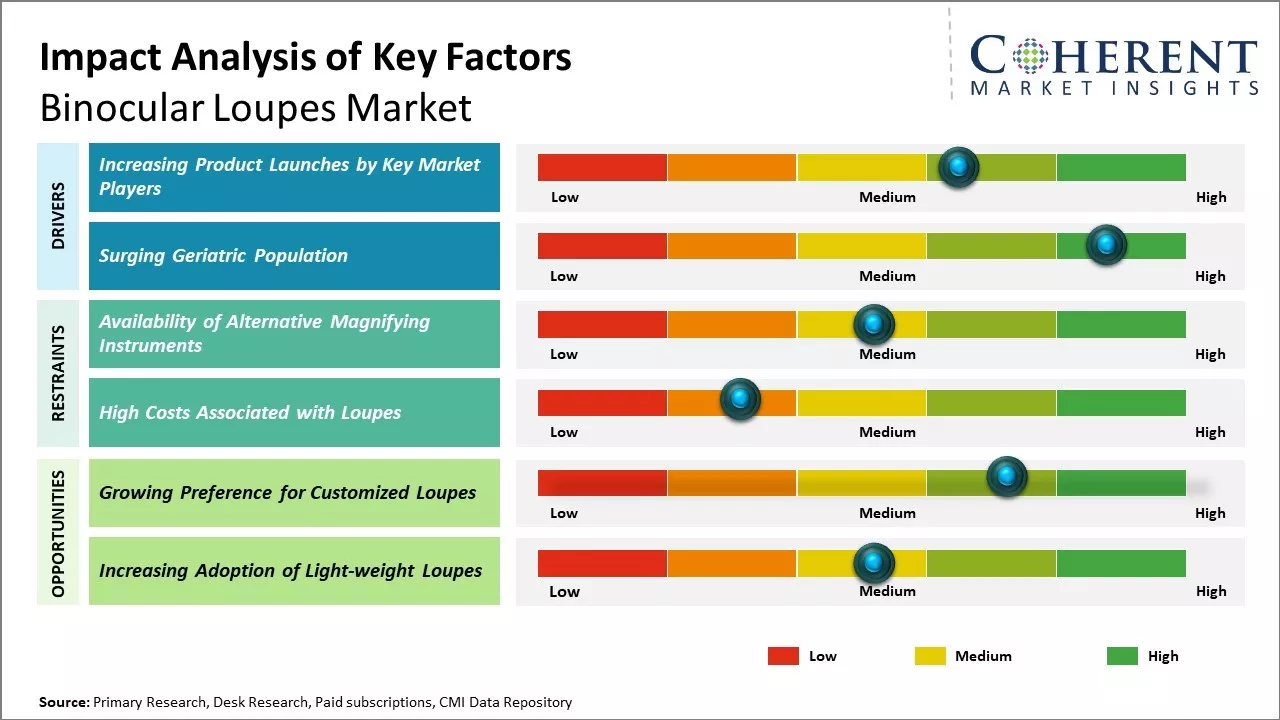
Discover market dynamics shaping the industry: Download Free Sample
Global binocular loupes market is expected to witness positive growth over the forecast period due to increasing dental diseases, rising geriatric population, growing medical tourism, and advancement in dental loupes technology. Furthermore, growing awareness about dental health and rising disposable income can also drive the market growth.
Increasing Product Launches by Key Market Players
Increasing adoption of organic growth strategies such as product launches by key market players is expected to drive the market growth over the forecast period. For instance, on January 25, 2025, Ocutrx Technologies, a virtual and augmented reality device manufacturer, launched an enhanced model of the ORLenz surgery headset. This surgical loupe device is designed to enhance a surgeon’s vision during spinal surgery through the use of augmented and Extended Reality (XR).
Market Concentration and Competitive Landscape
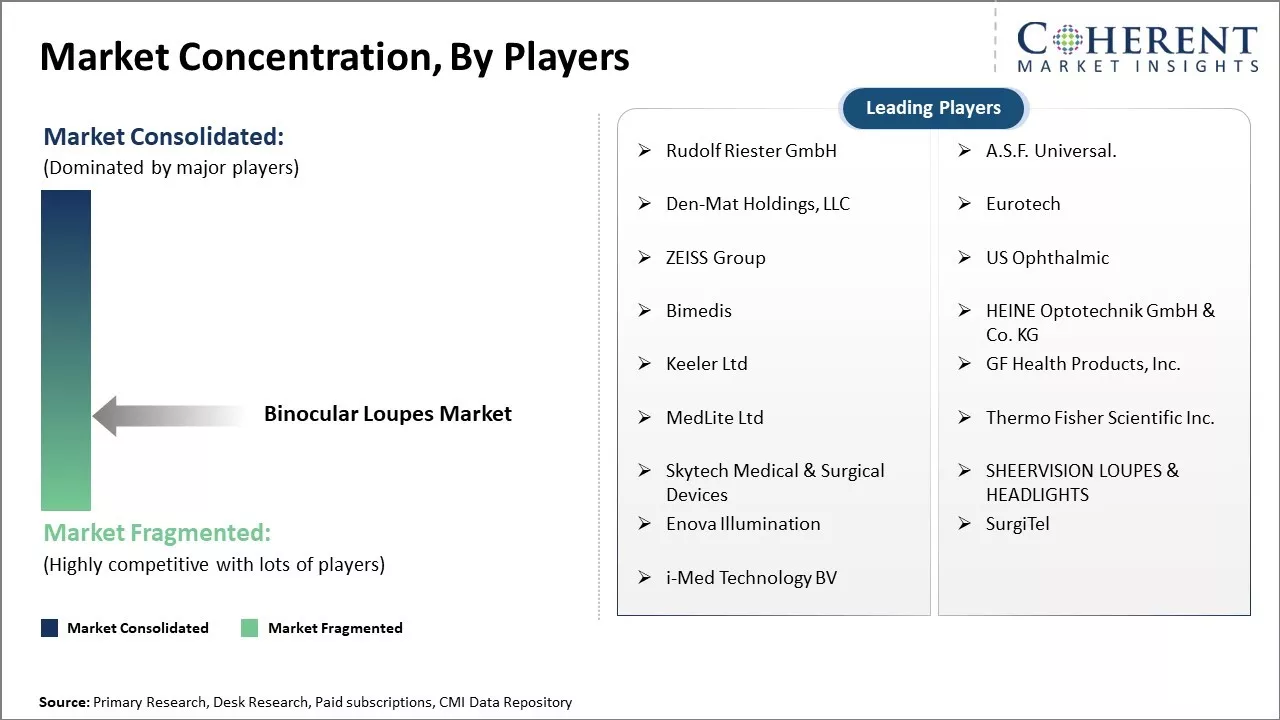
Get actionable strategies to beat competition: Download Free Sample
Surging Geriatric PopulationAdvanced healthcare and lifestyle changes has led to increase in average human lifespan globally. The worldwide geriatric population, defined as people aged 65 years and above, has grown exponentially over last few decades. Many developed nations now have over 20% of their total population classified as older persons. This demographic shift is gradually catching up in developing Asian, Latin American and African countries. Aged individuals are more prone to eyesight deterioration and diseases such as cataracts, macular degeneration and glaucoma. This expanding geriatric demographic pool increases ophthalmic consultations and procedures. Optometrists, ophthalmologists and refractive surgeons requires advanced visualization devices such as binocular loupes to efficiently manage the growing caseloads. Particularly for older patients with co-morbid conditions, minimally invasive procedures performed under loupe magnification translate to less trauma and quicker recovery. Rising proportion of elderly populations can boost demand for binocular loupes from both hospital intensive ophthalmic centers as well as standalone eye-care facilities globally.
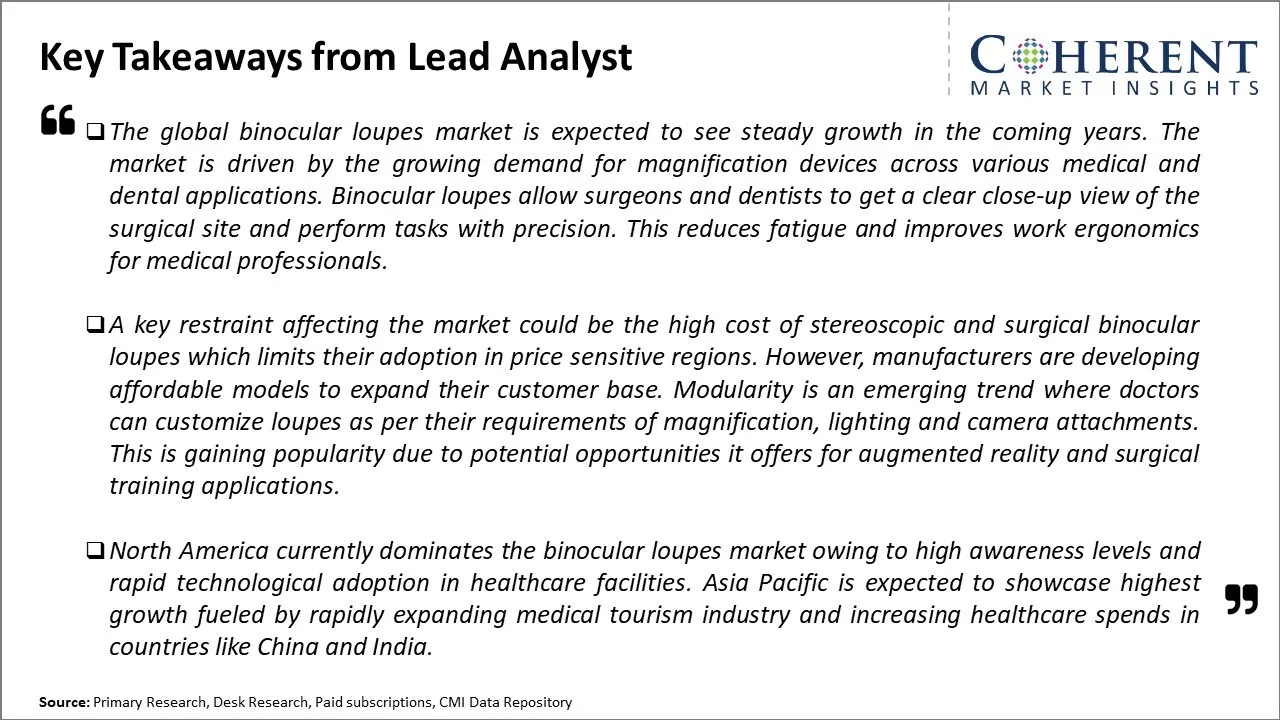
To learn more about this report, Download Free Sample
Market Challenge – Availability of Alternative Magnifying InstrumentsThe availability of alternative magnifying instruments can hamper the growth of the binocular loupes market. There are several advanced magnifying tools available that serve the same purpose as binocular loupes along with advantages. Microscopes provide much higher magnification as compared to loupes and allow observation of very fine details. Various types of microscopes are available for different applications like surgical microscopes for intricate surgeries. Diagnostic laboratories widely use digital microscopes connected to computers and screens for efficient examination of samples. Another alternative is head-mounted displays or smart glasses that can project magnified content directly onto the eyeglass lenses or screens near the eyes. These hands-free virtual reality solutions remove the need to hold loupes and provides flexibility. Many new models even integrate advanced features like recording capabilities.
Market Opportunity – Growing Preference for Customized Loupes
Growing preference for customized loupes offers a major opportunity for players in the binocular loupes market. Customers nowadays want loupes that are tailored to their specific needs and requirements. With technological advancements, manufacturers can now 3D scan an individual's face and eyes to gather precise anatomical measurements. Using this data, manufacturers can create fully customized loupes frames and lenses that fit the customer perfectly. This level of customization was not possible earlier and is highly valued by professionals like surgeons, dentists and others who have to wear loupes for long hours.
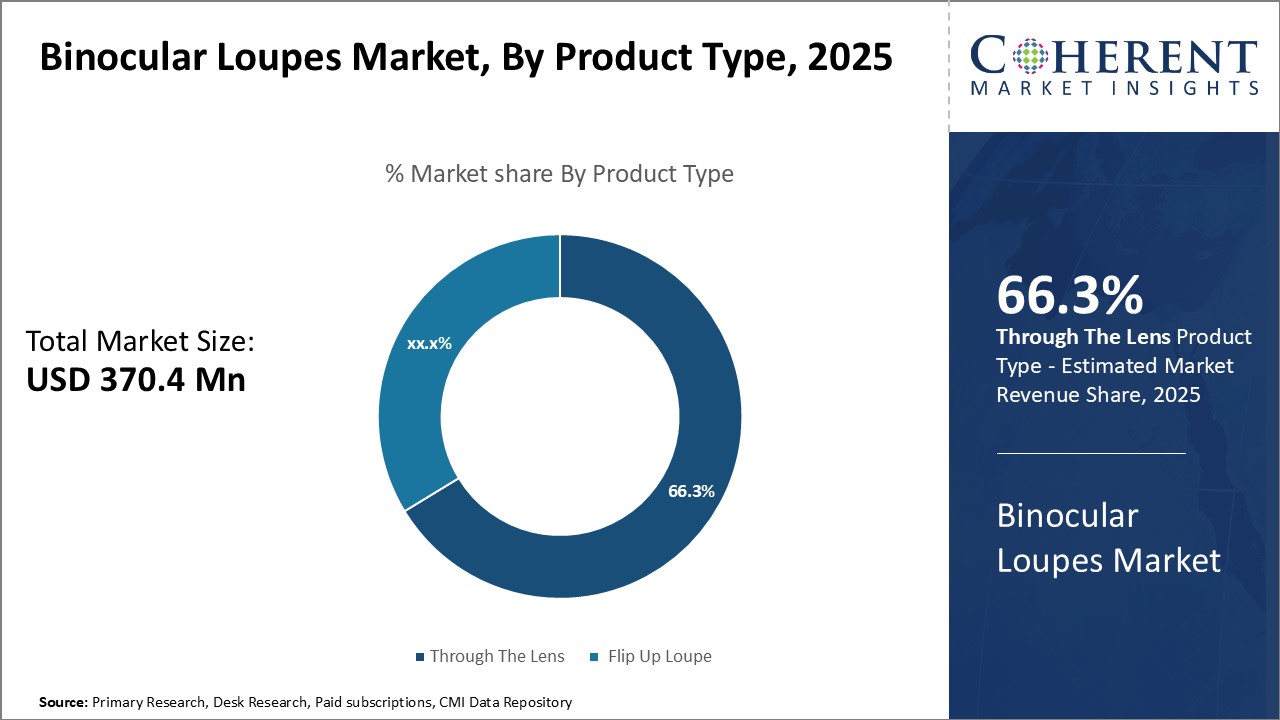
Discover high revenue pocket segments and roadmap to it: Download Free Sample
Insights, By Product Type: Convenience and precision boosts adoption of through the lens loupesProduct Type segment is sub-segmented into through the lens (TTL) and flip up loupe. Through the lens (TTL) sub-segment is estimated to hold 66.3% of the market share in 2025, owing to their convenience and precision. TTL loupes offer hands-free magnification as the magnification lenses are built into the eyepiece, allowing users to have an unobstructed view of their work through the loupes anytime. This provides improved ergonomics and ease of use as compared to flip up loupes which require users to lift and flip the eyepiece out of the way periodically. The constant magnification also allows for greater precision as users does not have to adjust to different magnification levels when flipping lenses in and out. The integrated design of TTL loupes makes them particularly suitable for delicate procedures requiring long periods of magnification such as dentistry, surgery or electronics work. This boosts productivity and efficiency in clinical and industrial settings. The convenience provided by TTL boosts its adoption among healthcare professionals and surgeons who perform numerous intricate procedures on a daily basis. The benefits of greater precision and an uninterrupted field of view through constant magnification have made TTL loupes the preferred choice for professionals requiring loupes routinely in their work.
Insights, By Type: Comfort drives preference for frame loupes
Type segment is sub-segmented into frames and without frames. Frames sub-segment is estimated to hold 53% of the market share in 2025, due to their comfort and ergonomic advantages over frameless styles. Frame loupes are worn like standard glasses with temples arms that wrap around the ears, distributing the weight across the head for all-day wear. This is more comfortable especially for procedures requiring prolonged use as compared to frameless styles where the weight of the loupes rest solely on the bridge of the nose. The secure fit of frame loupes means less fatigue over extended periods of concentration. Users appreciate how frames hold the loupes steady to minimize movement or slipping, thus, improving focus. Frames also prevent lens fogging issues more effectively than frameless designs by creating an airtight seal around the eyes. Some frames even incorporate anti-fog coatings to keep lenses clear at all times. Overall, frame loupes have become the preferred style among medical professionals and trade workers who need loupes for the majority of their day. The comfort, secure fit and convenience outweigh potential tradeoffs in weight or bulk from the frames. This drives loyalty to frame loupes that optimize ergonomics for lengthy, precision-focused applications.
Insights, By End User: Clinical relevance drives adoption among hospitals
End User segment is sub-segmented into hospitals, dental clinics, others. Hospitals sub-segment is estimated to hold 32.9% of the market share in 2025, due to the clinical relevance of loupes for various medical specialties. In hospital settings, loupes witness huge adoption across specialties such as dentistry, surgery, ophthalmology and dermatology where high magnification is essential for intricate procedures and examinations. Loupes allow clinicians to clearly see delicate structures and small details. This improves diagnostic capabilities and treatment outcomes. Their usage helps avoid injuries to physicians from strains over long procedures and reduces chances of errors from lack of visibility. Furthermore, as newer complex procedures advance, loupes become more integral to training and education within academic hospital environments. Their use standardizes best practices and skills transfer between clinicians. Hospitals recognize the value add of loupes in continuously enhancing clinical capabilities, workflows and standards of patient care.
Regional Insights
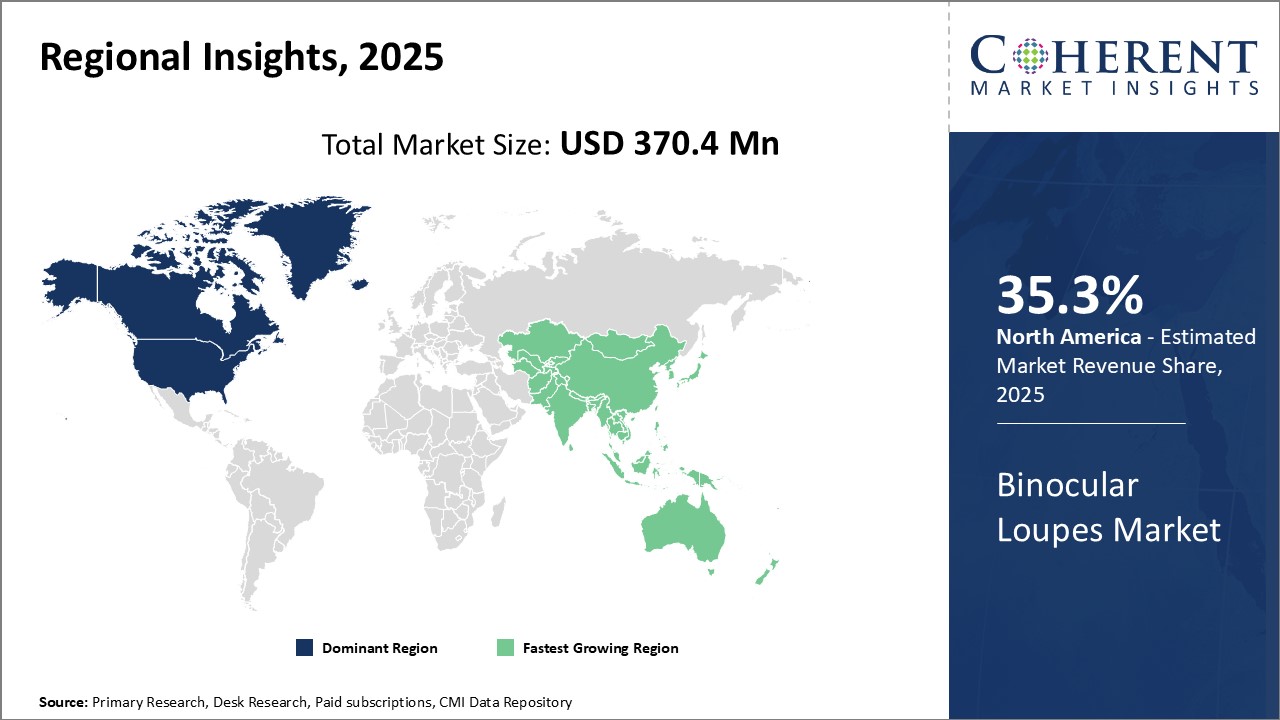
Need a Different Region or Segment? Download Free Sample
North America remains the dominant region in the global binocular loupes market and is estimated to hold 35.3% of the market share in 2025. The presence of major players along with the large base of optometrists and ophthalmologists in countries like the U.S. and Canada are expected to drive the regional market growth. There has been huge demand for high-quality loupes from dental and medical professionals in the region who prefer brands that offer advanced technologies. Moreover, North America has witnessed awareness about what? and adoption of loupes compared to other parts of the world.
Asia Pacific has emerged as the fastest growing regional market for binocular loupes due to rising healthcare standards and growing medical tourism industry in countries like India, China, Malaysia and Thailand. With populations of over one billion, India and China have huge pools of dental and medical practitioners seeking reliable magnification tools. Their large manufacturing sectors supply cost-effective loupes within the region and for export. Asia Pacific sees a proliferation of local brands catering to price-sensitive markets, which has increased accessibility of loupes.
Market Report Scope
Binocular Loupes Market Report Coverage
| Report Coverage | Details | ||
|---|---|---|---|
| Base Year: | 2024 | Market Size in 2025: | USD 370.4 Mn |
| Historical Data for: | 2020 To 2024 | Forecast Period: | 2025 To 2032 |
| Forecast Period 2025 to 2032 CAGR: | 11.5% | 2032 Value Projection: | USD 794.2 Mn |
| Geographies covered: |
|
||
| Segments covered: |
|
||
| Companies covered: |
Rudolf Riester GmbH, A.S.F. Universal., Den-Mat Holdings, LLC, Eurotech, ZEISS Group, US Ophthalmic, Bimedis, HEINE Optotechnik GmbH & Co. KG, Keeler Ltd, GF Health Products, Inc., MedLite Ltd, Thermo Fisher Scientific Inc., Skytech Medical & Surgical Devices, SHEERVISION LOUPES & HEADLIGHTS, Enova Illumination, SurgiTel, i-Med Technology BV |
||
| Growth Drivers: |
|
||
| Restraints & Challenges: |
|
||
Uncover macros and micros vetted on 75+ parameters: Get instant access to report
Binocular Loupes Industry News
- In September 2022, SurgiTel, a medical device company, announced the launch of ErgoDeflection Loupes. ErgoDeflection loupes is a customizable 40- to 50-degree deflection angle to match the clinician’s ideal working angle. ErgoDeflection loupes feature interchangeable working distance caps, and are designed to provide optimal ergonomics, comfort, and safety.
- In December 2020, i-Med Technology BV, a medical technology company, and Neways Electronics International N.V., a global player operating in electronics for semicon, connectivity and smart mobility solutions, announced a partnership for the production of the Head Mounted Digital Loupe (HMDL) and the 3D viewer based on this technology. The HMDL offers a solution for increasing complexity of surgical procedures.
*Definition: Binocular loupes are simple optical devices used for magnification, allowing users to view small details more closely. Unlike a magnifying glass, loupes are designed to be held or worn close to the eye, providing higher magnification than traditional magnifying glasses. These consist of a single lens or a compact combination of lenses that refract light to magnify objects. Binocular loupes are commonly used in various fields such as surgery, dentistry, jewelry, biology, electronics, and watchmaking for precision work that requires enhanced visual clarity.
Market Segmentation
- Product Type Insights (Revenue, USD Mn, 2020 - 2032)
- Through The Lens (TTL)
- Flip Up Loupe
- Type Insights (Revenue, USD Mn, 2020 - 2032)
- Frames
- Without Frames
- Lens Type Insights (Revenue, USD Mn, 2020 - 2032)
- Galilean
- Prismatic
- End User Insights (Revenue, USD Mn, 2020 - 2032)
- Hospitals
- Dental Clinics
- Others
- Regional Insights (Revenue, USD Mn, 2020 - 2032)
- North America
- U.S.
- Canada
- Latin America
- Brazil
- Argentina
- Mexico
- Rest of Latin America
- Europe
- Germany
- U.K.
- Spain
- France
- Italy
- Russia
- Rest of Europe
- Asia Pacific
- China
- India
- Japan
- Australia
- South Korea
- ASEAN
- Rest of Asia Pacific
- Middle East
- GCC
- Israel
- Rest of Middle East
- Africa
- South Africa
- North Africa
- Central Africa
- North America
- Key Players Insights
- Rudolf Riester GmbH
- A.S.F. Universal.
- Den-Mat Holdings, LLC
- Eurotech
- ZEISS Group
- US Ophthalmic
- Bimedis
- HEINE Optotechnik GmbH & Co. KG
- Keeler Ltd
- GF Health Products, Inc.
- MedLite Ltd
- Thermo Fisher Scientific Inc.
- Skytech Medical & Surgical Devices
- SHEERVISION LOUPES & HEADLIGHTS
- Enova Illumination
- SurgiTel
- i-Med Technology BV
Share
Share
About Author
Komal Dighe is a Management Consultant with over 8 years of experience in market research and consulting. She excels in managing and delivering high-quality insights and solutions in Health-tech Consulting reports. Her expertise encompasses conducting both primary and secondary research, effectively addressing client requirements, and excelling in market estimation and forecast. Her comprehensive approach ensures that clients receive thorough and accurate analyses, enabling them to make informed decisions and capitalize on market opportunities.
Missing comfort of reading report in your local language? Find your preferred language :
Transform your Strategy with Exclusive Trending Reports :
Frequently Asked Questions
EXISTING CLIENTELE
Joining thousands of companies around the world committed to making the Excellent Business Solutions.
View All Our Clients
